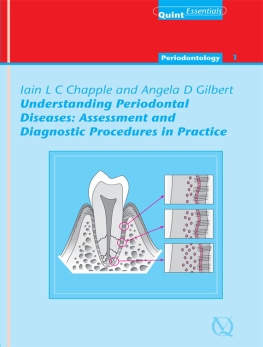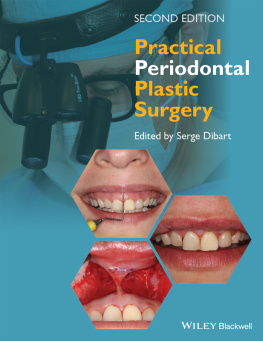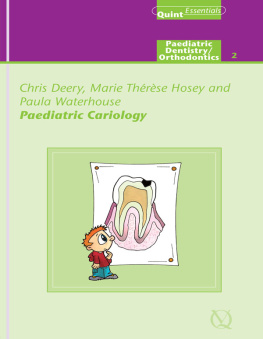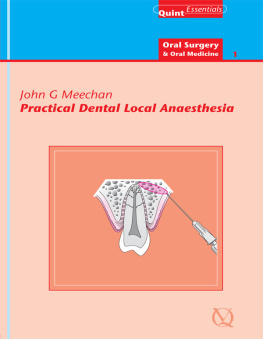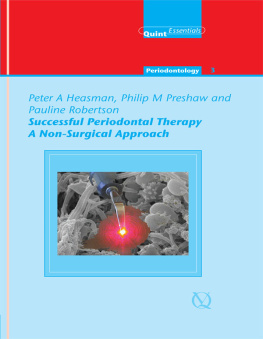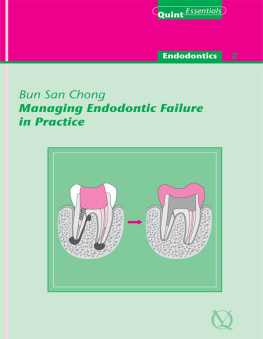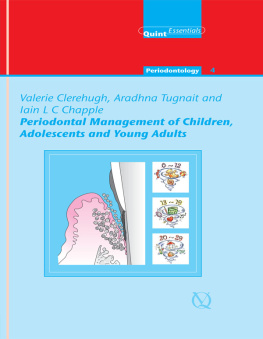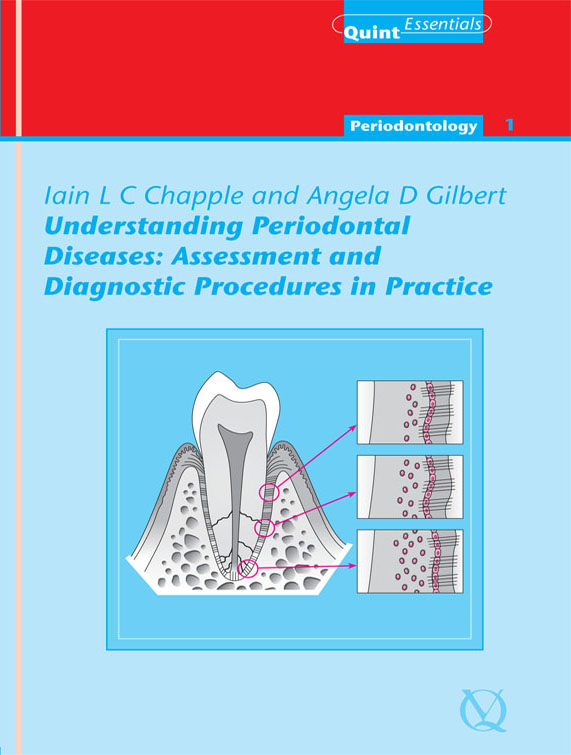
Quintessentials of Dental Practice 1
Periodontology 1
Understanding Periodontal Diseases
Assessment and Diagnostic Procedures in Practice
Authors:
Iain L C Chapple
Angela D Gilbert
Editors:
Nairn H F Wilson
Iain L C Chapple

Quintessence Publishing Co. Ltd.
London, Berlin, Chicago, Copenhagen, Paris, Milan, Barcelona, Istanbul, So Paulo, Tokyo, New Dehli, Moscow, Prague, Warsaw
British Library Cataloguing in Publication Data
Chapple, Iain L. (Iain Leslie)
Understanding periodontal diseases: assessment and diagnostic procedures in practice. - (The quintessentials of dental practice)
1. Periodontal disease - Diagnosis 2. Periodontal disease - Treatment
I. Title II. Gilbert, Angela D. III. Wilson, Nairn H. F. 617.632
1-85097-308-3
Copyright 2002 Quintessence Publishing Co. Ltd., London
All rights reserved. This book or any part thereof may not be reproduced, stored in a retrieval system, or transmitted inany form or by any means, electronic, mechanical, photocopying, or otherwise, without the written permission of the publisher.
ISBN 1-85097-308-3
This text is dedicated to my daughter,
Jessica Louise Chapple, born 7 September 2001.
Iain L C Chapple
Foreword
Knowledge and understanding of the periodontal tissues and diseases are fundamental to the provision of effective oral healthcare.This first volume in the Quintessentials for General Dental Practitioners Series presents this knowledge and understandingin a succinct, authoritative, easy-to-read engaging style.
Each chapter includes aims, anticipated outcomes, high-quality illustrations to complement the text and carefully selectedsuggestions for further reading features which will characterise the attractive range of books to follow in the QuintessentialsSeries. As a rich mine of information and guidance essential to good-quality periodontology in everyday clinical practice,Understanding Periodontal Diseases has a good deal to offer both established practitioners of all ages and student members of the dental team.
With a growing awareness of the benefits of oral health, patients living longer and retaining an increasing number of teeththroughout life, periodontology as presented in Understanding Periodontal Diseases is an essential element of successful clinical practice. For all those striving to improve the provision of oral healthcarefor their patients, this book, in common with the volumes to follow in the Quintessentials Series, provides a most valuableasset the means for all practitioners to apply the latest knowledge and understanding for the benefit of patients and thefurther development of the art and science of dentistry. I commend Understanding Periodontal Diseases to you as an outstanding first volume in the Quintessentials for Dental Practitioners Series.
Nairn H F Wilson
Editor-in-Chief
Preface
This text is the first of five books which aim to provide the general dental practitioner with an illustrated practical andcontemporary guide to the management of patients with gingival and periodontal diseases. The first book in the series is entitledUnderstanding Periodontal Diseases: Assessment and Diagnostic Procedures in Practice and takes the reader on a logical journey through the assessment and diagnostic processes to enable practitioners to avoiddiagnostic pitfalls and to identify risk patients for periodontitis. It provides summary background revision of anatomical issues and those relating to the disease process,clinical signs of health and disease and current concepts of disease classification. The reader is then led through a clinicaldiagnostic algorithm, including radiological and other special investigations and is provided with a look into the futurefor periodontal diagnosis.
Having Read This Book
It is hoped that having read this book the reader will be able to:
Understand current concepts of the periodontal disease process, its classification and clinical course.
Understand the concept of risk assessment and what risk factors are, and be able to assign a level of risk for their patientslosing teeth due to periodontitis.
Identify healthy and diseased periodontal tissues, in their broadest sense, and understand how such features fit into currentclassification systems.
Diagnose the most common gingival and periodontal diseases/lesions.
Follow a simple periodontal diagnostic algorithm, including radiological and other special investigations, thereby ensuringthat disease does not go undetected.
Decide on the most appropriate radiographs to take and to prepare and document a concise report of the key findings from suchinvestigations.
Understand which special tests are required for certain conditions and what the results mean.
Broadly categorise lesions affecting the periodontal tissues and form differential diagnoses for such conditions.
Picture where periodontal diagnosis may be heading over the next ten years and therefore prepare their practice for potentialchange.
Iain L C Chapple
Angela D Gilbert
Acknowledgements
The authors would like to acknowledge with sincere thanks the following people. Dr John Strange and Dr Barbara Shearer forproof-reading the entire manuscript; Dr John Matthews for proof-reading Chapters 2 and 3; Mr Michael Sharland and Miss MarinaTipton for their photographic expertise; Dr Rachel Sammons for Figs 2-2, 2-3, 2-4, 2-5, 3-7; Mr H Donald Glenwright for theuse of Fig 4-9; Dr John Rippin for the use of Figs 1-1, 1-4, 1-5; Dr Serge Dibart for the use of Figs 1-7 and 5-8; Dr ElizabethConnor and her staff for radiological expertise and material; Mr Paul Hughes for his help with illustrations and Mosby YearBook Europe Limited for allowing us to reprint Figs 6-2 and 6-4.
Professor Chapple would like to acknowledge the help and support of his wife, Liz, throughout this venture. Dr Gilbert wouldlike to thank Nigel, and her sisters Isobell and Joan for their unstinting support.
Chapter 1
A Whistle-Stop Tour of the Periodontium
Aim
This chapter aims to provide the practitioner with a contemporary review of the important anatomical and micro-anatomicalfeatures of the periodontium.
Outcome
At the end of this chapter the practitioner should be able to identify key clinical features that need to be assessed duringthe examination of patients periodontal tissues, since these features help inform diagnostic and treatment-planning processes.
Terminology and Orientation
The periodontal tissues form the supporting apparatus of the teeth. Their role is to protect the teeth from masticatory forcesand infection, thereby facilitating normal oral function and preventing premature tooth loss. As modern medicine and standardsof health have prolonged human life expectancy the periodontal tissues have to perform these functions over considerably moreyears than they were designed for, and therefore recession, sensitivity and tooth mobility are daily management problems forthe dental practitioner and patient. Additionally, the nature and extent of systemic problems that are created by a compromisedperiodontal attachment (e.g. the established link between periodontal disease and cardio-/cerebro-vascular disease) and thechronic microbial stimulus associated with retaining teeth for longer, is only just being realised. The healthy periodontaltissues are identified in Fig 1-1 and comprise:
Next page
